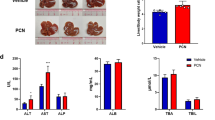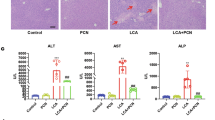Abstract
The severity of sepsis is attributed to excessive inflammatory responses leading to liver injury. Pregnane X receptor (PXR), a nuclear receptor that controls xenobiotic and endobiotic metabolism, has been implicated in regulating inflammation and liver regeneration. This study aimed to investigate the role of PXR in sepsis-induced liver injury and the underlying mechanisms. Sepsis models were established in mice, the mice were administered the typical mouse PXR agonist PCN (100 mg·kg−1·d−1, i.p.) for 3 consecutive days in advance, then subjected to CLP operation or LPS administration 1 h after the last administration of PCN. The results showed that PCN pretreatment significantly increased the survival rate of septic mice, while the survival rate was reduced after the knockout of Pxr. In addition, PCN pretreatment effectively alleviated sepsis-induced liver injury. In Pxr knockout mice, liver injury was more severe, whereas the protective effects of PCN pretreatment were abolished. Mechanistically, PCN pretreatment significantly upregulated the expression of yes-associated protein (YAP) and its downstream targets and decreased the level of phosphorylated nuclear factor-κB (NF-κB). Moreover, liver-specific knockdown of Yap blocked the protective effects of PCN pretreatment against sepsis-induced liver injury and downregulated the phosphorylation level of NF-κB. In summary, this study demonstrated that PXR activation protects against sepsis-induced liver injury through activation of the YAP signaling pathway, providing a new strategy for the diagnosis and treatment of sepsis-induced liver injury.
This is a preview of subscription content, access via your institution
Access options
Subscribe to this journal
Receive 12 print issues and online access
$259.00 per year
only $21.58 per issue
Buy this article
- Purchase on SpringerLink
- Instant access to full article PDF
Prices may be subject to local taxes which are calculated during checkout








Similar content being viewed by others
References
Evans L, Rhodes A, Alhazzani W, Antonelli M, Coopersmith CM, French C, et al. Surviving sepsis campaign: international guidelines for management of sepsis and septic shock 2021. Intensive Care Med. 2021;47:1181–247.
Singer M, Deutschman CS, Seymour CW, Shankar-Hari M, Annane D, Bauer M, et al. The Third International Consensus Definitions for Sepsis and Septic Shock (Sepsis-3). JAMA. 2016;315:801–10.
Rudd KE, Johnson SC, Agesa KM, Shackelford KA, Tsoi D, Kievlan DR, et al. Global, regional, and national sepsis incidence and mortality, 1990-2017: analysis for the Global Burden of Disease Study. Lancet. 2020;395:200–11.
Strnad P, Tacke F, Koch A, Trautwein C. Liver - guardian, modifier and target of sepsis. Nat Rev Gastroenterol Hepatol. 2017;14:55–66.
Xie J, Wang H, Kang Y, Zhou L, Liu Z, Qin B, et al. The epidemiology of sepsis in Chinese ICUs: A national cross-sectional survey. Crit Care Med. 2020;48:e209–e18.
Cheng B, Xie G, Yao S, Wu X, Guo Q, Gu M, et al. Epidemiology of severe sepsis in critically ill surgical patients in ten university hospitals in China. Crit Care Med. 2007;35:2538–46.
Cai X, Young GM, Xie W. The xenobiotic receptors PXR and CAR in liver physiology, an update. Biochim Biophys Acta Mol Basis Dis. 2021;1867:166101.
Xie W, Barwick JL, Downes M, Blumberg B, Simon CM, Nelson MC, et al. Humanized xenobiotic response in mice expressing nuclear receptor SXR. Nature. 2000;406:435–9.
Kliewer SA, Moore JT, Wade L, Staudinger JL, Watson MA, Jones SA, et al. An orphan nuclear receptor activated by pregnanes defines a novel steroid signaling pathway. Cell. 1998;92:73–82.
Liang HF, Yang X, Li HL, Li X, Tian JN, Su HG, et al. Activation of pregnane X receptor protects against cholestatic liver injury by inhibiting hepatocyte pyroptosis. Acta Pharmacol Sin. 2025;46:147–58.
Wu S, Lu H, Wang W, Song L, Liu M, Cao Y, et al. Prevention of D-GalN/LPS-induced ALI by 18β-glycyrrhetinic acid through PXR-mediated inhibition of autophagy degradation. Cell Death Dis. 2021;12:480.
Dring MM, Goulding CA, Trimble VI, Keegan D, Ryan AW, Brophy KM, et al. The pregnane X receptor locus is associated with susceptibility to inflammatory bowel disease. Gastroenterology. 2006;130:341–8. quiz 592.
Zhao T, Zhong G, Wang Y, Cao R, Song S, Li Y, et al. Pregnane X receptor activation in liver macrophages protects against endotoxin-induced liver injury. Adv Sci (Weinh). 2024;11:e2308771.
Wang S, Xiong L, Ruan Z, Gong X, Luo Y, Wu C, et al. Indole-3-propionic acid alleviates sepsis-associated acute liver injury by activating pregnane X receptor. Mol Med. 2023;29:65.
Li X, Fan S, Cai C, Gao Y, Wang X, Zhang Y, et al. YAP regulates the liver size during the fasting-refeeding transition in mice. Acta Pharm Sin B. 2023;13:1588–99.
Fu M, Hu Y, Lan T, Guan KL, Luo T, Luo M. The Hippo signalling pathway and its implications in human health and diseases. Signal Transduct Target Ther. 2022;7:376.
Patel SH, Camargo FD, Yimlamai D. Hippo signaling in the liver regulates organ size, cell fate, and carcinogenesis. Gastroenterology. 2017;152:533–45.
Lv Y, Kim K, Sheng Y, Cho J, Qian Z, Zhao YY, et al. YAP controls endothelial activation and vascular inflammation through TRAF6. Circ Res. 2018;123:43–56.
Wang J, Zhu Q, Li R, Zhang J, Ye X, Li X. YAP1 protects against septic liver injury via ferroptosis resistance. Cell Biosci. 2022;12:163.
Zhang S, Guo M, Jiang X, Tang L, Wu T, Bi G, et al. PXR triggers YAP-TEAD binding and Sirt2-driven YAP deacetylation and polyubiquitination to promote liver enlargement and regeneration in mice. Pharmacol Res. 2023;188:106666.
Jiang Y, Feng D, Ma X, Fan S, Gao Y, Fu K, et al. Pregnane X receptor regulates liver size and liver cell fate by Yes-associated protein activation in mice. Hepatology. 2019;69:343–58.
Zhang PH, Zhang WW, Wang SS, Wu CH, Ding YD, Wu XY, et al. Efficient pulmonary lymphatic drainage is necessary for inflammation resolution in ARDS. JCI Insight 2024;9.
Xie S, Li J, Lyu F, Xiong Q, Gu P, Chen Y, et al. Novel tripeptide RKH derived from Akkermansia muciniphila protects against lethal sepsis. Gut. 2023;73:78–91.
Chen X, Wu R, Li L, Zeng Y, Chen J, Wei M, et al. Pregnancy-induced changes to the gut microbiota drive macrophage pyroptosis and exacerbate septic inflammation. Immunity. 2023;56:336–52.e9.
Pascussi JM, Robert A, Nguyen M, Walrant-Debray O, Garabedian M, Martin P, et al. Possible involvement of pregnane X receptor-enhanced CYP24 expression in drug-induced osteomalacia. J Clin Invest. 2005;115:177–86.
Dawulieti J, Sun M, Zhao Y, Shao D, Yan H, Lao YH, et al. Treatment of severe sepsis with nanoparticulate cell-free DNA scavengers. Sci Adv. 2020;6:eaay7148.
Fang S, Wang T, Li Y, Xue H, Zou J, Cai J, et al. Gardenia jasminoides Ellis polysaccharide ameliorates cholestatic liver injury by alleviating gut microbiota dysbiosis and inhibiting the TLR4/NF-κB signaling pathway. Int J Biol Macromol. 2022;205:23–36.
Yao XP, Jiao TY, Jiang YM, Fan SC, Zhao YY, Yang X, et al. PXR mediates mifepristone-induced hepatomegaly in mice. Acta Pharmacol Sin. 2022;43:146–56.
Wagner M, Halilbasic E, Marschall HU, Zollner G, Fickert P, Langner C, et al. CAR and PXR agonists stimulate hepatic bile acid and bilirubin detoxification and elimination pathways in mice. Hepatology. 2005;42:420–30.
Ouellette DR, Moscoso EE, Corrales JP, Peters M. Sepsis outcomes in patients receiving statins prior to hospitalization for sepsis: comparison of in-hospital mortality rates between patients who received atorvastatin and those who received simvastatin. Ann Intensive Care. 2015;5:9.
Merx MW, Liehn EA, Graf J, van de Sandt A, Schaltenbrand M, Schrader J, et al. Statin treatment after onset of sepsis in a murine model improves survival. Circulation. 2005;112:117–24.
Paumelle R, Haas JT, Hennuyer N, Baugé E, Deleye Y, Mesotten D, et al. Hepatic PPARα is critical in the metabolic adaptation to sepsis. J Hepatol. 2019;70:963–73.
Hao H, Cao L, Jiang C, Che Y, Zhang S, Takahashi S, et al. Farnesoid X receptor regulation of the NLRP3 inflammasome underlies cholestasis-associated sepsis. Cell Metab. 2017;25:856–67.e5.
Bi G, Liang F, Wu T, Wang P, Jiang X, Hu S, et al. Pregnane X receptor activation induces liver enlargement and regeneration and simultaneously promotes the metabolic activity of CYP3A1/2 and CYP2C6/11 in rats. Basic Clin Pharmacol Toxicol. 2024;135:148–63.
Acknowledgements
The research work was supported by the National Natural Science Foundation of China (Grants U23A20535, 82025034, 82274001, 82304603 and 82304457), the National Key R&D Program of China (Grant 2022YFA1104900, 2022YFA1106700), the Shenzhen Science and Technology Program (Grant KQTD20190929174023858), the Science and Technology Innovation Project of Guangdong Medical Products Administration (Grant 2023ZDZ06), the Guangdong Basic and Applied Basic Research Foundation (Grant SL2022A04J01943, 2023A1515012859) and the Local Innovative and Research Teams Project of Guangdong Pearl River Talents Program (Grant 2017BT01Y093).
Author information
Authors and Affiliations
Contributions
HCB, JHF, and XY conceived and designed the project. CHW, SH, DL, XWJ, HOY, GFB, PW, FTL, and WHZ performed the experiments. HCB, CHW, and JHF wrote and revised the manuscript.
Corresponding author
Ethics declarations
Competing interests
The authors declare no competing interests.
Additional information
Publisher’s note Springer Nature remains neutral with regard to jurisdictional claims in published maps and institutional affiliations.
Rights and permissions
Springer Nature or its licensor (e.g. a society or other partner) holds exclusive rights to this article under a publishing agreement with the author(s) or other rightsholder(s); author self-archiving of the accepted manuscript version of this article is solely governed by the terms of such publishing agreement and applicable law.
About this article
Cite this article
Wu, Ch., Hu, S., Li, D. et al. Pregnane X receptor alleviates sepsis-induced liver injury through activation of yes-associated protein in mice. Acta Pharmacol Sin 46, 2423–2435 (2025). https://doi.org/10.1038/s41401-025-01552-4
Received:
Accepted:
Published:
Issue date:
DOI: https://doi.org/10.1038/s41401-025-01552-4



